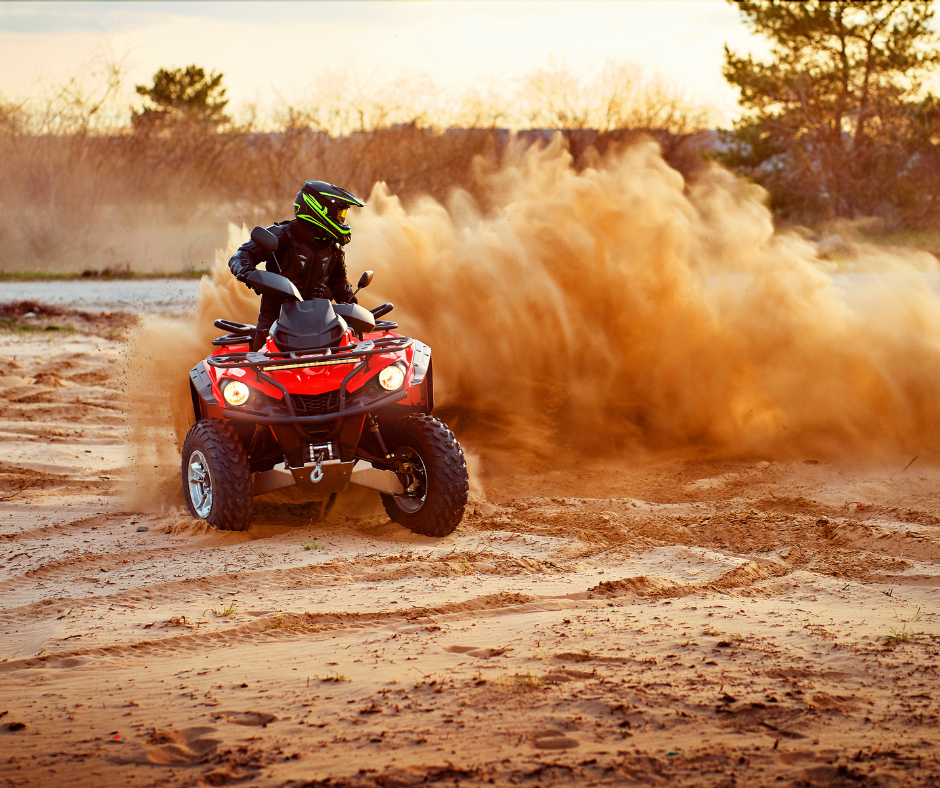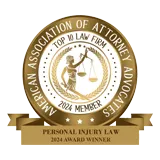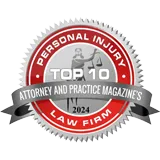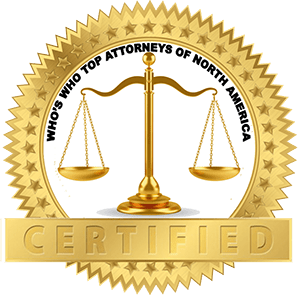Wisconsin Side by Side ATV Accident Lawyer

All-terrain vehicles (ATVs), utility task vehicles (UTVs), and side-by-side (SxS) vehicles offer a fast, powerful way to explore the outdoors. From wooded trails to farmland and snow-covered fields, these vehicles can handle rugged terrain and carry multiple passengers, making them a popular choice across Wisconsin.
But with that freedom comes a real risk of injury. Side-by-side accidents happen more often than many expect, and the consequences can be serious when they do. If you were injured in a side-by-side ATV accident in Wisconsin, it is important to understand your rights and what steps to take next. At Nowlan Personal Injury Law, we help injured riders and passengers recover compensation after off-road vehicle crashes caused by negligence, product defects, or unsafe conditions.
Who Can Be Held Responsible for a Side-by-Side Accident?
Determining who is legally responsible for a side-by-side accident depends on how the crash occurred, as more than one party may be at fault. Common examples include:
- Negligent Drivers: If another person was operating the side-by-side and caused the crash, they may be personally liable for your injuries. Examples of negligent operation include driving too fast for conditions, ignoring weight limits, attempting unsafe terrain, and failing to provide passengers with safety gear.
- Property Owners: If your crash happened due to unsafe trail conditions, poor maintenance, or hidden hazards, a property owner may be responsible. This is especially true if they invited riders onto the land without properly warning them of dangers or maintaining safe trails. Wisconsin’s recreational immunity laws may limit legal claims against landowners in some cases, but exceptions exist for known hazards and commercial properties.
- Manufacturers: If the accident was caused by a mechanical failure or defective part, the manufacturer, distributor, or repair provider may be held liable under product liability laws. Common claims include design flaws, manufacturing defects, or failure to warn users about known risks. A product liability case may require expert investigation, recall records, and documentation of vehicle maintenance.
Wisconsin ATV and UTV Laws That May Affect Your Case
Wisconsin has laws that apply to the operation of ATVs and UTVs, especially when minors are involved. These laws are in place to reduce the risk of serious injury and to promote responsible vehicle operation. If you’re injured in a side-by-side or other ATV-related crash, understanding these rules can help clarify how they might affect your personal injury claim.
Helmet Requirements
All operators and passengers under the age of 18 are required by Wisconsin law to wear a DOT-approved helmet when riding an ATV or UTV on public roads, lands, trails, and routes. Helmets must be properly fitted and fastened to meet compliance.
This rule applies regardless of whether the rider is operating the vehicle or simply riding as a passenger. Failing to wear a helmet may increase the severity of any crash injuries in a crash and impact how much compensation a rider may recover in a personal injury claim, particularly if the injury involved head trauma.
Safety Certification
If you were born on or after January 1, 1988, you must complete an ATV safety education course approved by the Wisconsin Department of Natural Resources (DNR) before operating an ATV or UTV on public land. Once completed, you must carry proof of certification at all times while operating the vehicle.
The safety course covers essential topics, including:
- Vehicle handling and control
- Safe riding practices
- Environmental awareness
- Emergency procedures
- Legal responsibilities under Wisconsin law
Failing to complete the course or not carrying proof of certification while operating an ATV or UTV can result in citations. In a personal injury case, it may also affect your legal claim, especially if your lack of certification is connected to how the accident occurred.
Age Restrictions for Operation on Public Trails
Wisconsin law sets clear age limits for operating ATVs and UTVs:
- Children under 12 years old may not operate an ATV or UTV on public trails, even if they are under supervision or wearing protective gear.
- Children between 12 and 15 years old may operate an ATV on public trails if they have completed a DNR-approved safety course and are under the supervision of an adult.
- Operators must be at least 16 years old to operate a UTV on public trails, and they must still complete the safety course if they were born after January 1, 1988.
Parents or guardians who knowingly allow underage or uncertified children to operate these vehicles on public lands may also face legal consequences and could share liability if an accident occurs.
How Violations May Affect Your Injury Claim
Violating Wisconsin’s ATV and UTV laws does not automatically disqualify you from pursuing a personal injury claim. However, it can affect how your case is evaluated, particularly if your own actions contributed to the crash or increased the severity of your accident injuries.
For example:
- If a rider under 18 was not wearing a helmet and suffered a head injury, the insurance company may argue that the injury could have been avoided or reduced with proper protection.
- If the operator was underage, untrained, or not safety certified, the defense may use that fact to shift some degree of fault to the injured party or their legal guardians.
- If a parent allowed a child under 12 to operate a vehicle on a public trail in violation of state law, and that child caused an accident, the parent may be held partially responsible.
Under Wisconsin’s comparative negligence law, any percentage of fault assigned to the injured person reduces the amount of compensation they can receive. If the rider is found to be more than 50 percent at fault, they may be barred from recovery entirely. At Nowlan Personal Injury Law, we can help you understand your rights and how state regulations may impact your legal claim.
What Financial Compensation Can You Recover?
If you were injured in a side-by-side accident due to someone else’s negligence or a defective vehicle, you may be entitled to compensation for:
- Medical expenses (current and future)
- Lost income
- Loss of future earning potential
- Pain and suffering
- Emotional distress
- Property damage
- Disability or disfigurement
- Loss of quality of life
If the accident involved a fatality, surviving family members may be able to file a wrongful death claim to recover for funeral costs, lost support, and loss of companionship.
What to Do After a Side-by-Side ATV Accident
If you are involved in an ATV or UTV crash, take the following steps as soon as possible:
- Get medical attention even if injuries seem minor. Some symptoms can take hours or days to appear.
- Report the accident to law enforcement, especially if it occurred on public land.
- Document the accident scene with photos or video. Include the vehicle, terrain, and any visible hazards.
- Collect information from witnesses and others involved.
- Do not sign anything or speak with insurance adjusters before consulting a personal injury attorney.
- Preserve the vehicle if a defect or mechanical issue may be involved. It may be critical evidence.
About Side-by-Side Accidents
Side-by-side vehicles, commonly known as SxS or UTVs (Utility Task Vehicles), are a class of off-road vehicles designed to transport multiple passengers while navigating rugged, uneven terrain. Unlike traditional ATVs or “quads,” which usually have straddle seating for a single rider and limited safety features, these off-highway vehicles feature a more car-like setup. They include bucket or bench-style seats arranged side by side, seat belts, roll cages, foot pedals, and a steering wheel, rather than handlebars.
Side-by-sides are marketed as versatile, all-purpose vehicles. They have added features like cargo beds, tow hitches, winches, and suspension systems that can handle steep inclines, rocks, mud, snow, and loose gravel. Some are equipped with roof panels, doors, and windshields, but these features vary widely by model and trim.
While their enclosed design includes more safety measures than a standard ATV, it is important to understand that these vehicles are not crash-rated like passenger cars or trucks. They are not required to meet federal safety standards for street-legal vehicles because they are not intended for highway use. Still, many side-by-sides can reach speeds of 60 miles per hour or more, especially when driven on flat or downhill terrain. At that maximum speed, even small obstacles or terrain changes can lead to rollovers or high-impact collisions.
Regardless of how the vehicle is marketed, all side-by-sides share inherent risk factors: high centers of gravity, open cabins, and limited protective structure in the event of a collision or rollover. Even with full-face helmets and seat belts, riders and passengers can suffer catastrophic injuries in accidents, especially if the vehicle rolls or tips.
Common Causes of Side-by-Side ATV Accidents
Side-by-side crashes happen for many reasons. Knowing the common causes can help you identify whether negligence or a mechanical failure contributed to your injury.
Rollover Accidents
Rollovers are one of the most common and dangerous types of side-by-side accidents. These off-highway vehicles have a high center of gravity and a wide frame, which can make them more likely to tip, especially on slopes or uneven ground. Poor weight distribution, sharp turns, or steep drops can all lead to a rollover.
Rollover accidents often result in severe injuries, including head trauma, spinal cord injuries, and broken bones. Even with roll cages and safety belts, passengers may be crushed, ejected, or pinned during a rollover event.
Excessive Speed
Side-by-sides can reach highway speeds, but their braking systems and suspension are not built like passenger vehicles. Driving too fast for the terrain is a major factor in many off-road crashes. Obstacles like rocks, tree roots, or mud can quickly turn deadly when approached at high speed.
ATV and UTV trails in Wisconsin often contain sharp turns, elevation changes, or debris. Exceeding a safe speed limit affects a driver’s ability to respond in time, making collisions or loss of control more likely.
Overloading
Every utility vehicle has a weight limit, which includes passengers and cargo. When side-by-sides are overloaded, especially with unbalanced weight, it increases the risk of a rollover or mechanical failure.
Overloading can strain the brakes, suspension, and tires, leading to loss of control or a breakdown in dangerous conditions. This is a common safety issue on job sites, farms, or trail rides where passengers or workers may be unaware of load limits.
Inexperienced or Young Drivers
Under Wisconsin law, children as young as 12 may operate an ATV, and teens over 16 may drive a UTV, as long as they complete an approved safety course. Despite legal limits, young drivers are more likely to take risks or misjudge terrain.
Side-by-sides may give a false sense of security because of their seat belts and roll cages. This can lead to more aggressive driving, particularly among teenagers riding with friends. Without proper training or supervision, the risk of an accident increases significantly.
Mechanical Failures and Defects
Defective parts or poor maintenance can contribute to serious accidents. Common mechanical problems include:
- Brake failure
- Steering system defects
- Fuel system leaks
- Engine overheating
- Tire blowouts
- Suspension failure
Side-by-side vehicles are often used in rough, dirty environments that accelerate wear and tear. If a defective part caused your accident, the manufacturer, distributor, or service provider may be held legally responsible.
What Injuries Are Common in Side-by-Side Accidents?
Injuries from side-by-side ATV accidents can range from minor to life-altering. Common injuries include:
- Broken bones
- Concussions and other closed-head injuries
- Traumatic brain injuries
- Facial injuries
- Arm injuries
- Spinal cord injuries and paralysis
- Internal bleeding
- Burns (especially in engine fire cases)
- Crush injuries
- Severe lacerations or amputations
These injuries often require hospitalization, surgery, and long-term rehabilitation. In many cases, accident victims are left with permanent disabilities or limited mobility, especially if ejected from the vehicle or pinned in a rollover.
How Our ATV Accident Lawyers Can Help
At Nowlan Personal Injury Law, we know that side-by-side ATV accident cases can be as complicated as they are catastrophic. Our legal team works with accident reconstruction experts, product engineers, and medical professionals to build strong, evidence-based claims. We also handle the insurance companies so you can focus on healing from your injuries.
Whether the crash happened on a trail, farm, or private land, we can investigate the cause, identify the responsible parties, and help you pursue the compensation you are entitled to. For more information or to schedule a free initial consultation with a personal injury attorney, call us today.














